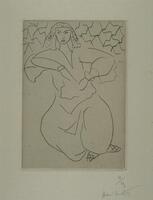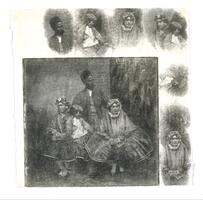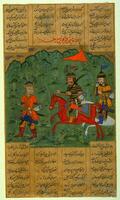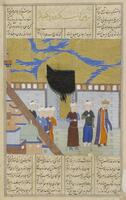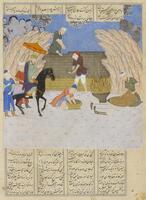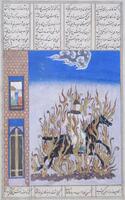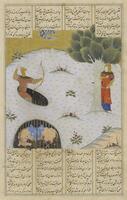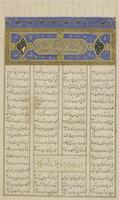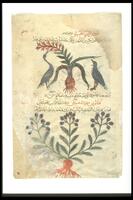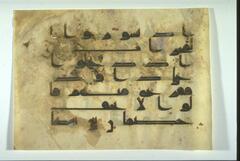10 Items in this Learning Collection
Collection Object
Collection Object
Collection Object
Collection Object
Collection Object
Collection Object
Copyright
All Rights Reserved
()
Sikandar Builds a Barrier Against Yajuj and Majuj, from the Shahnama of Firdausi
Accession Number
1963/1.66
Title
Sikandar Builds a Barrier Against Yajuj and Majuj, from the Shahnama of Firdausi
Artist(s)
Iranian
Artist Nationality
Iranian
Object Creation Date
circa 1460
Medium & Support
ink, opaque watercolor, and gold leaf on paper
Dimensions
10 1/2 in. x 7 in. ( 26.7 cm x 17.8 cm )
Credit Line
Museum Purchase
Label copy
Yajuj and Majuj are the Islamic counterparts to Gog and Magog of the Jewish and Christian scriptures: they represent hostile forces who will appear at the apocalypse to sow chaos. The Qur’an relates a tale that Sikander (Alexander the Great) built a great wall to trap Yajuj and Majuj in the mountains beyond the headwaters of the Tigris and Euphrates, to contain them until the end of the world.
He ordered [them] to bring blacksmiths, copper, brass,
And heavy hammers, mortar, stone, and fire-wood. . . .
The experts mustered, and he built two walls
Across the mountain-pass from base to crest,
One hundred royal cubits broad, one cubit
Of charcoal, one of iron, in between
Strewed copper, and showered sulphur in the midst . . .
And when from top to bottom all was set,
They mixed much ghee and naphtha, poured it over
Those substances, and on the top shot charcoal
In ass-loads. Then the Shah bade fire the whole,
And five score thousand smiths blew up the flames . . .
Thus passed a season with the fire in blast,
And smiths a-toil. They ran the substances
Together, fusing them in that fierce blaze.
Thus was the world delivered from Yajuj
And from Majuj, and earth grew habitable . . .
Warner, VI, 164–65
This scene is unique in this manuscript in providing a glimpse of laborers and technology: one man works the bellows for a fire and another mixes mortar in a large basin, while two more lay bricks in the background. The hammers and pliers on the ground are drawn with remarkable precision. Combined with these realistic elements—probably taken from the painter’s own observations of daily life—are the stylized figures of Sikander and his horse, and a wildly animated landscape, where the very mountains threaten to crash down like a tidal wave on the wall and Sikander’s labors.
———
Maribeth Graybill, Senior Curator of Asian Art
Exhibited in "A Medieval Masterpiece from Baghdad: the Ann Arbor Shahnama"
August 14 through December 19, 2004
Subject matter
Sikandar Builds A Barrier Against Yajuj and Majuj
He ordered to bring blacksmiths, copper, brass,
And heavy hammers, mortar, stone, and fire-wood...
...The experts mustered, and he built two walls
Across the mountain-pass from base to crest,
One hundred royal cubits broad, one cubit
Of charcoal, one of iron, in between
Strewed copper, and showered sulphur in the midst...
...And when from top to bottom all was set,
They mixed much ghee and naphtha, poured it over
Those substances, and on the top shot charcoal
In ass-loads, Then he Shah bade fire the whole,
And five score thousand smiths blew up the flames...
Thus passed a season with the fire in blast,
And smiths a-toil. They ran the substances
Together, fusing them in that fierce blaze.
Thus was the world delivered from Yajuj
And from Majuj, and earth grew habitable....
Physical Description
This Persian miniature is attributed to the Shiraz and Timurid schools, ca. 1460. The painting is done in ink, opaque watercolor and gold leaf on paper. The scene, Sikandar Builds a Barrier Against Yajuj and Majuj, is part of the Shahnama of Firdausi, the Persian book of kings.
Primary Object Classification
Painting
Collection Area
Western
Rights
If you are interested in using an image for a publication, please visit http://umma.umich.edu/request-image for more information and to fill out the online Image Rights and Reproductions Request Form. Keywords
Iranian Islamic painting styles after the Mongols
Iranian Islamic styles after the Mongols
Persian-Farsi (language)
Shahnama
Timurid
Timurid painting styles
gold leaf
gouache (technique)
miniatures (paintings)
shahs
umbrella
watercolor painting (technique)
1963/1.66
Title
Sikandar Builds a Barrier Against Yajuj and Majuj, from the Shahnama of Firdausi
Artist(s)
Iranian
Artist Nationality
Iranian
Object Creation Date
circa 1460
Medium & Support
ink, opaque watercolor, and gold leaf on paper
Dimensions
10 1/2 in. x 7 in. ( 26.7 cm x 17.8 cm )
Credit Line
Museum Purchase
Label copy
Yajuj and Majuj are the Islamic counterparts to Gog and Magog of the Jewish and Christian scriptures: they represent hostile forces who will appear at the apocalypse to sow chaos. The Qur’an relates a tale that Sikander (Alexander the Great) built a great wall to trap Yajuj and Majuj in the mountains beyond the headwaters of the Tigris and Euphrates, to contain them until the end of the world.
He ordered [them] to bring blacksmiths, copper, brass,
And heavy hammers, mortar, stone, and fire-wood. . . .
The experts mustered, and he built two walls
Across the mountain-pass from base to crest,
One hundred royal cubits broad, one cubit
Of charcoal, one of iron, in between
Strewed copper, and showered sulphur in the midst . . .
And when from top to bottom all was set,
They mixed much ghee and naphtha, poured it over
Those substances, and on the top shot charcoal
In ass-loads. Then the Shah bade fire the whole,
And five score thousand smiths blew up the flames . . .
Thus passed a season with the fire in blast,
And smiths a-toil. They ran the substances
Together, fusing them in that fierce blaze.
Thus was the world delivered from Yajuj
And from Majuj, and earth grew habitable . . .
Warner, VI, 164–65
This scene is unique in this manuscript in providing a glimpse of laborers and technology: one man works the bellows for a fire and another mixes mortar in a large basin, while two more lay bricks in the background. The hammers and pliers on the ground are drawn with remarkable precision. Combined with these realistic elements—probably taken from the painter’s own observations of daily life—are the stylized figures of Sikander and his horse, and a wildly animated landscape, where the very mountains threaten to crash down like a tidal wave on the wall and Sikander’s labors.
———
Maribeth Graybill, Senior Curator of Asian Art
Exhibited in "A Medieval Masterpiece from Baghdad: the Ann Arbor Shahnama"
August 14 through December 19, 2004
Subject matter
Sikandar Builds A Barrier Against Yajuj and Majuj
He ordered to bring blacksmiths, copper, brass,
And heavy hammers, mortar, stone, and fire-wood...
...The experts mustered, and he built two walls
Across the mountain-pass from base to crest,
One hundred royal cubits broad, one cubit
Of charcoal, one of iron, in between
Strewed copper, and showered sulphur in the midst...
...And when from top to bottom all was set,
They mixed much ghee and naphtha, poured it over
Those substances, and on the top shot charcoal
In ass-loads, Then he Shah bade fire the whole,
And five score thousand smiths blew up the flames...
Thus passed a season with the fire in blast,
And smiths a-toil. They ran the substances
Together, fusing them in that fierce blaze.
Thus was the world delivered from Yajuj
And from Majuj, and earth grew habitable....
Physical Description
This Persian miniature is attributed to the Shiraz and Timurid schools, ca. 1460. The painting is done in ink, opaque watercolor and gold leaf on paper. The scene, Sikandar Builds a Barrier Against Yajuj and Majuj, is part of the Shahnama of Firdausi, the Persian book of kings.
Primary Object Classification
Painting
Collection Area
Western
Rights
If you are interested in using an image for a publication, please visit http://umma.umich.edu/request-image for more information and to fill out the online Image Rights and Reproductions Request Form. Keywords
Iranian Islamic painting styles after the Mongols
Iranian Islamic styles after the Mongols
Persian-Farsi (language)
Shahnama
Timurid
Timurid painting styles
gold leaf
gouache (technique)
miniatures (paintings)
shahs
umbrella
watercolor painting (technique)
